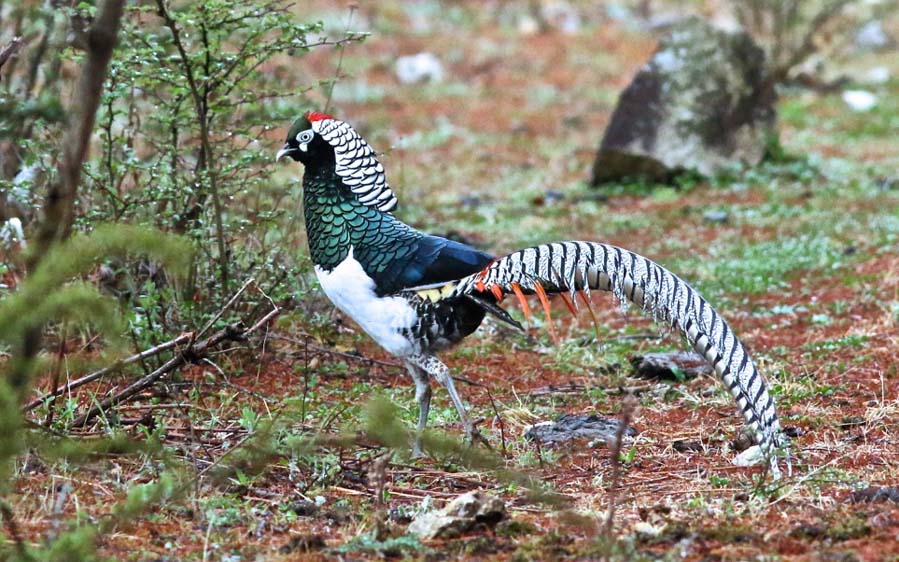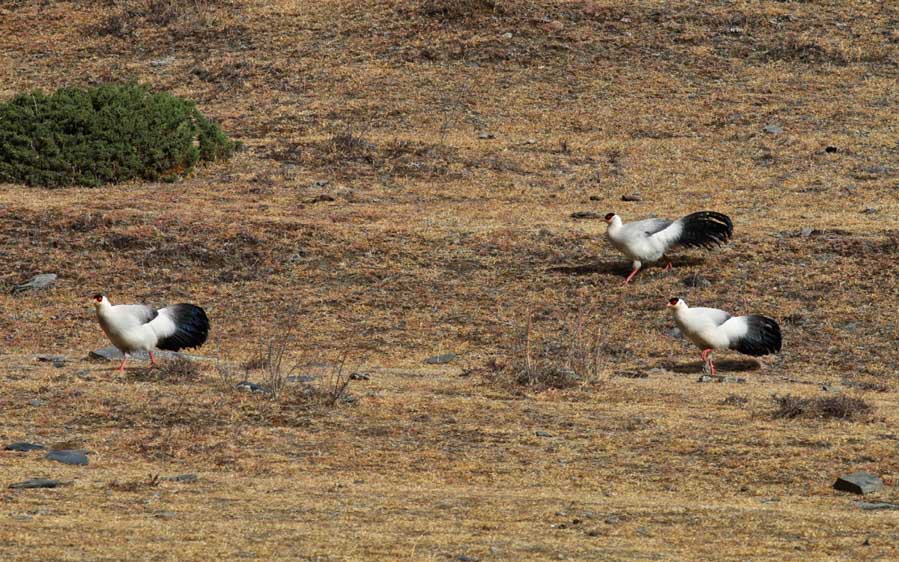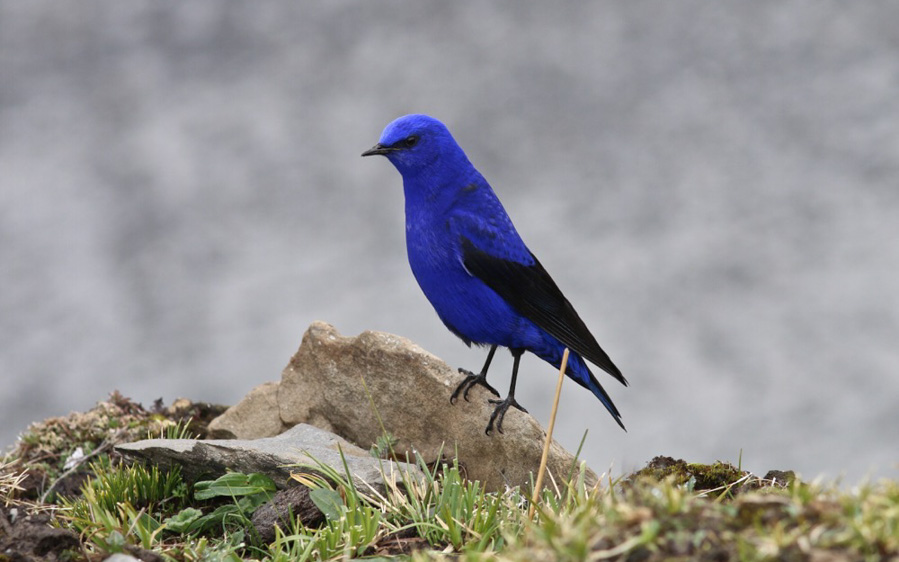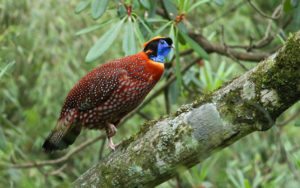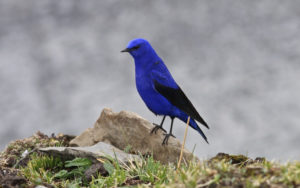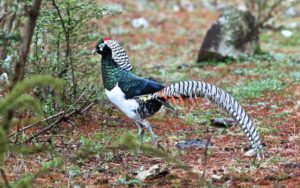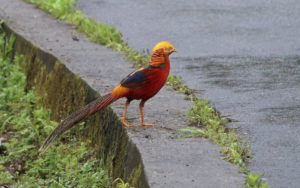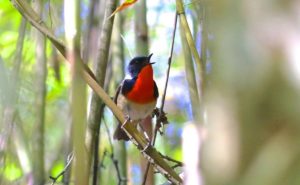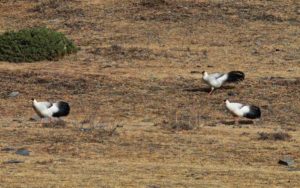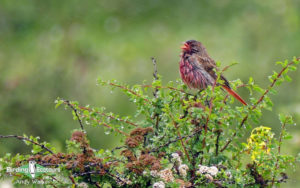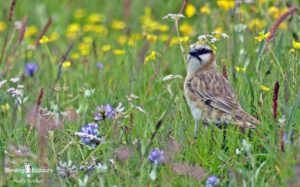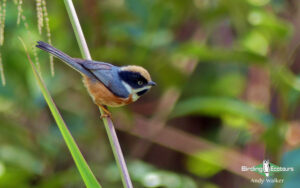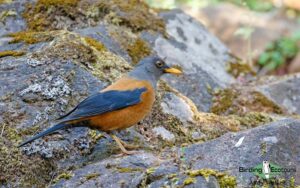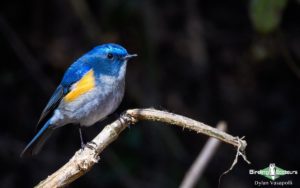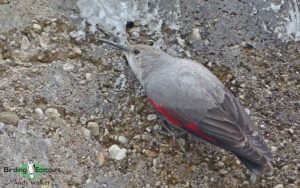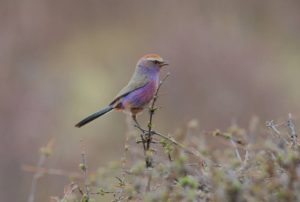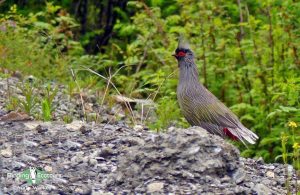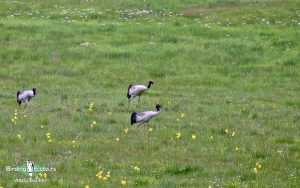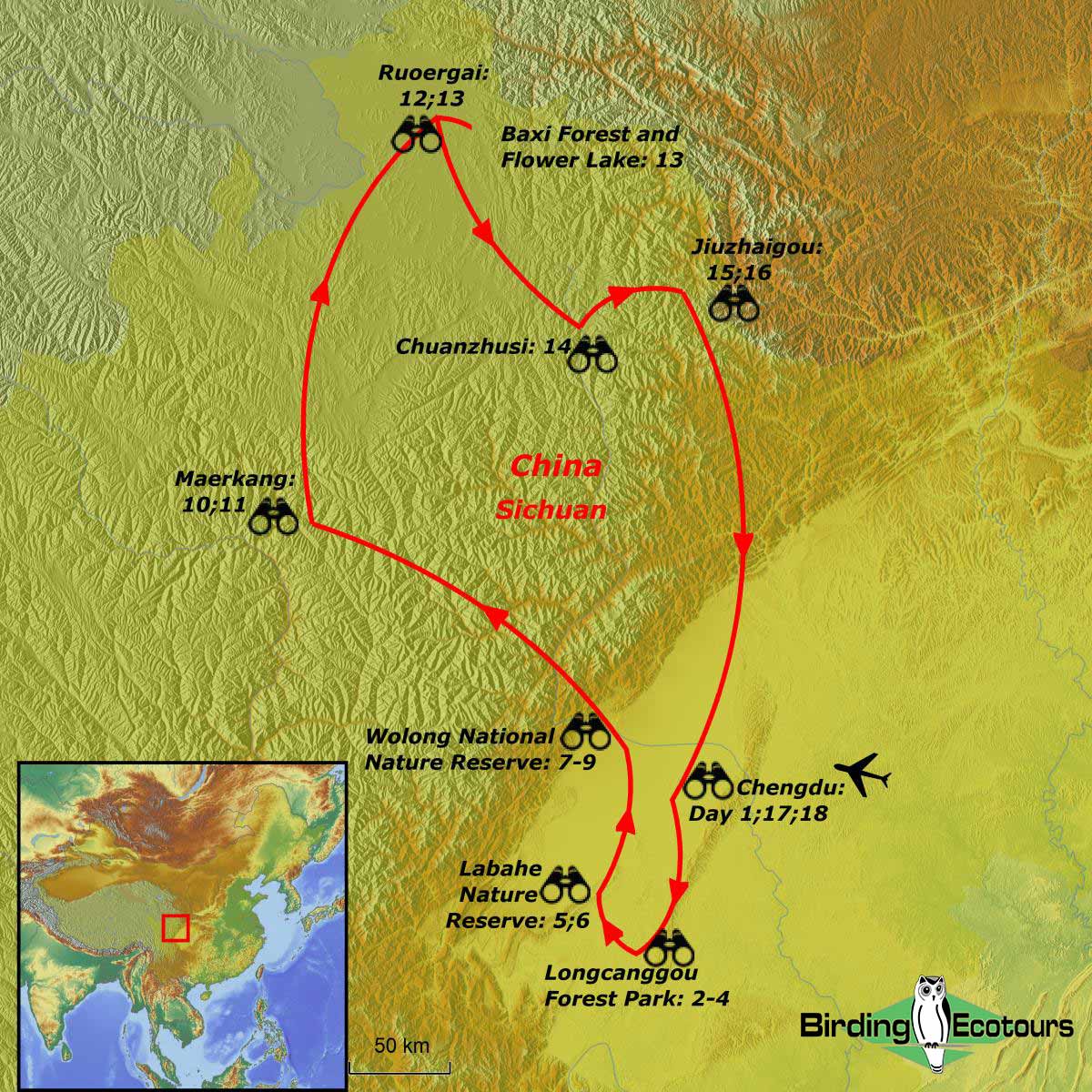Birding Tour China: Sichuan Tour
Go to: China Birding Tours | Taiwan Birding Tours | Birding Tours in Asia | All our birding tours
China: Sichuan Tour
May 2026
Sichuan offers an excellent introduction to birdwatching in China with large numbers of endemic and special species, set in some seriously stunning mountain landscapes. The huge, mountainous province of Sichuan is blessed with a range of interesting habitats, and we will ensure that we visit a representative sample of as many of these as possible in our quest to find the region’s exciting birds. The tour will start and end in Chengdu, the capital of the province, and we will visit the renowned Longcanggou Forest Park, Labahe Nature Reserve, Wolong National Nature Reserve with Balang Shan, the slopes of Mengbi Shan, and the Baxi Forest areas in our search for birds.
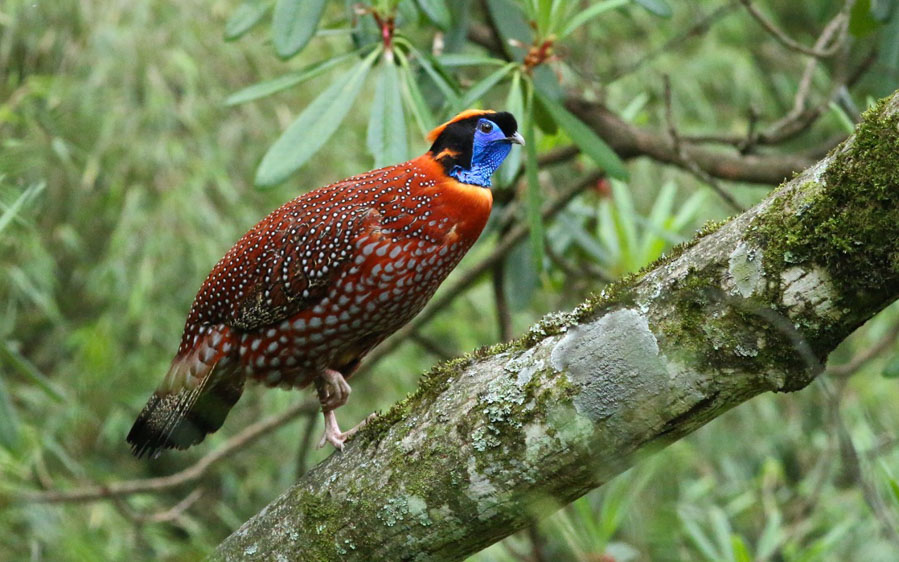
We will find many gorgeous game birds, parrotbills, laughingthrushes, and rosefinches during the tour, with particular highlights likely to include Chinese Monal, Blood Pheasant, White Eared Pheasant, Blue Eared Pheasant, Golden Pheasant, Lady Amherst’s Pheasant, Tibetan Snowcock, Temminck’s Tragopan, Snow Partridge, Black-necked Crane, Giant Laughingthrush, Firethroat, Golden Bush Robin, Chinese Rubythroat, Siberian Rubythroat, Emei Shan Liocichla, Grandala, Przevalski’s Nuthatch, Pere David’s Tit, Sichuan Tit, Wallcreeper, Crested Tit-warbler, and Przevalski’s Finch along with a near-endless list of interesting thrushes, chats, and warblers. Throw in some excellent food, friendly local people, with a great infrastructure, and a fantastic, bird-filled trip is on the cards.
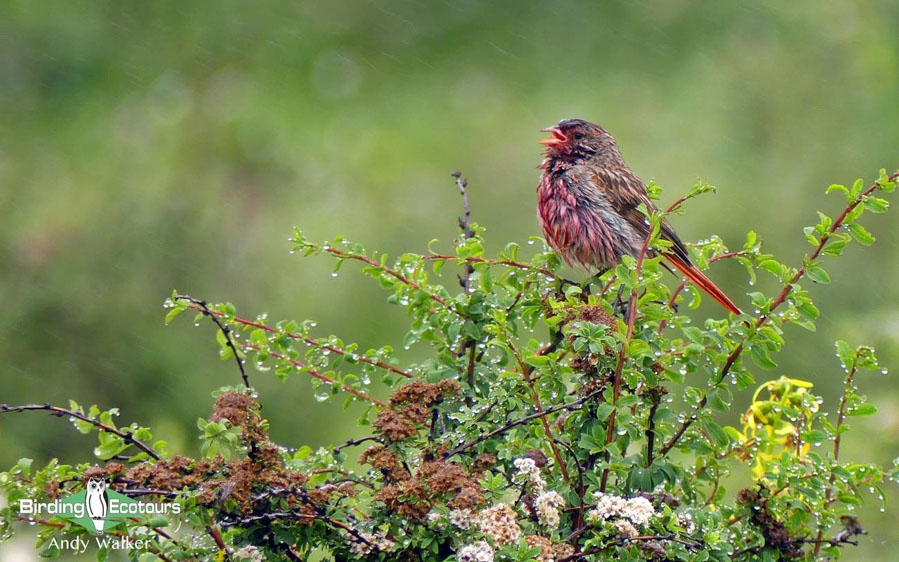
This Sichuan tour can be combined with our China: Yunnan Tour (before) and/or with our China: Qinghai Tour (after) to make a mind-boggling 43-day China mega tour. It is even possible to combine it with our Taiwan: Birding Extravaganza tour, which precedes the Yunnan tour.
Itinerary (18 days/17 nights)
Day 1. Arrival in Chengdu
Arrival into Chengdu Shuangliu International Airport, where you will be met and taken to our nearby hotel and welcome dinner. Depending on arrival times there may be time for some relaxed birding in the city.
Overnight: Chengdu
Day 2. Morning birding at Chengdu Panda Base and afternoon travel to Longcanggou
This morning we will drive to the Chengdu Research Base of Giant Panda Breeding. Built in 1987 jointly by the Chinese government and WWF, the base aims at helping captive Giant Pandas to increase their population in order to help pandas in the wild. After years of construction this base now covers about 100 hectares of land. The peaceful environment of the research base has made it an excellent habitat for birds. During the morning we will search the Chengdu parks for Vinous-throated Parrotbill, Black-throated Bushtit, Chinese Grosbeak, Red-billed Leiothrix, Rufous-faced Warbler, Chinese Bamboo Partridge, and White-browed Laughingthrush, as well as a range of other more widespread and common species. After lunch, on our drive to Longcanggou Forest Park, we will look for Ashy-throated Parrotbill.
Overnight: Longcanggou Forest Park
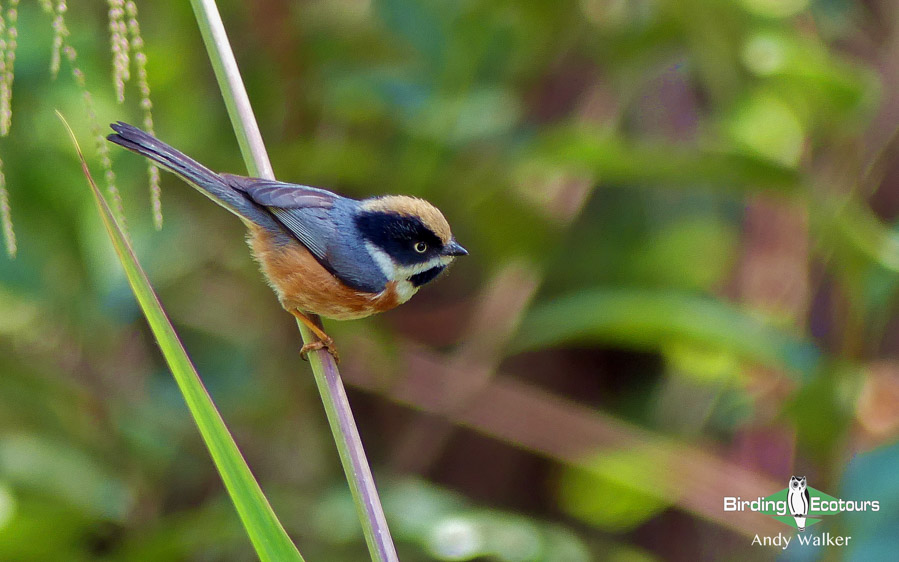
Days 3 – 4. Birding Longcanggou Forest Park
We will have two full days birding here in some beautiful landscapes and a range of forested and more open habitats. This is a fantastic area to bird and is sure to be an early tour highlight. We will look for a range of spectacular gamebirds, such as Temminck’s Tragopan, Chinese Bamboo Partridge, Lady Amherst’s Pheasant, Golden Pheasant, Common Pheasant, and Silver Pheasant.
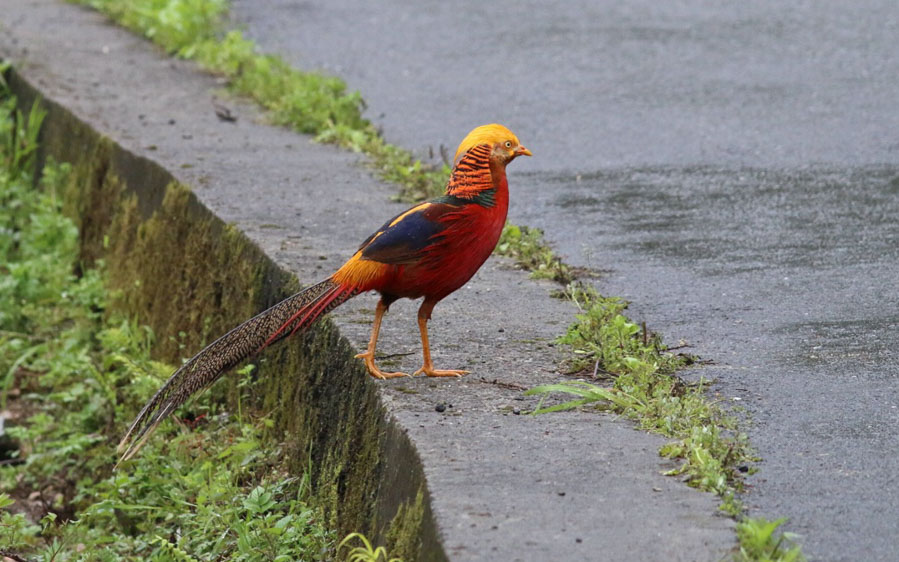
There are so many wonderful birds here it is tough to know where to start, over 300 species have been recorded from the local area. Parrotbills are particularly well represented, and we will be looking for five species: Grey-hooded Parrotbill, Three-toed Parrotbill, Golden Parrotbill, Great Parrotbill, and Brown Parrotbill.
The area holds plenty of small birds (more on those later) and so it is no surprise to find out that a good selection of brood-parasitic cuckoos can be found here. We will keep our ears, and eyes, open for Large Hawk-Cuckoo, Hodgson’s Hawk-Cuckoo, Lesser Cuckoo, Himalayan Cuckoo, Common Cuckoo, and Oriental Cuckoo while overhead we will keep our eyes peeled for the agile White-throated Needletail and Pacific Swift, both huge swifts. Also overhead we might find Crested Honey Buzzard, Black Baza, Mountain Hawk-Eagle, Grey-faced Buzzard, and a range of migratory Accipiters, including Chinese Sparrowhawk and Eurasian Sparrowhawk. At night we will have the chance for Oriental Scops Owl and Himalayan Owl, and during the day, Collared Owlet.
The forests themselves hold some amazing birds and we could find Red-headed Trogon, Great Barbet, Speckled Piculet, White-backed Woodpecker, Darjeeling Woodpecker, Great Spotted Woodpecker, Crimson-breasted Woodpecker, Bay Woodpecker, and Grey-headed Woodpecker. Open areas in the woodlands could hold Tiger Shrike, Brown Shrike, Long-tailed Shrike, Grey-backed Shrike, and Eurasian Hoopoe. Corvids, tits, and flycatchers are well represented, with five, ten, and 14 species possible respectively, as are leaf warblers, with at least 22 species available! Emei Leaf Warbler, Kloss’s Leaf Warbler, and Sichuan Leaf Warbler being the top picks.
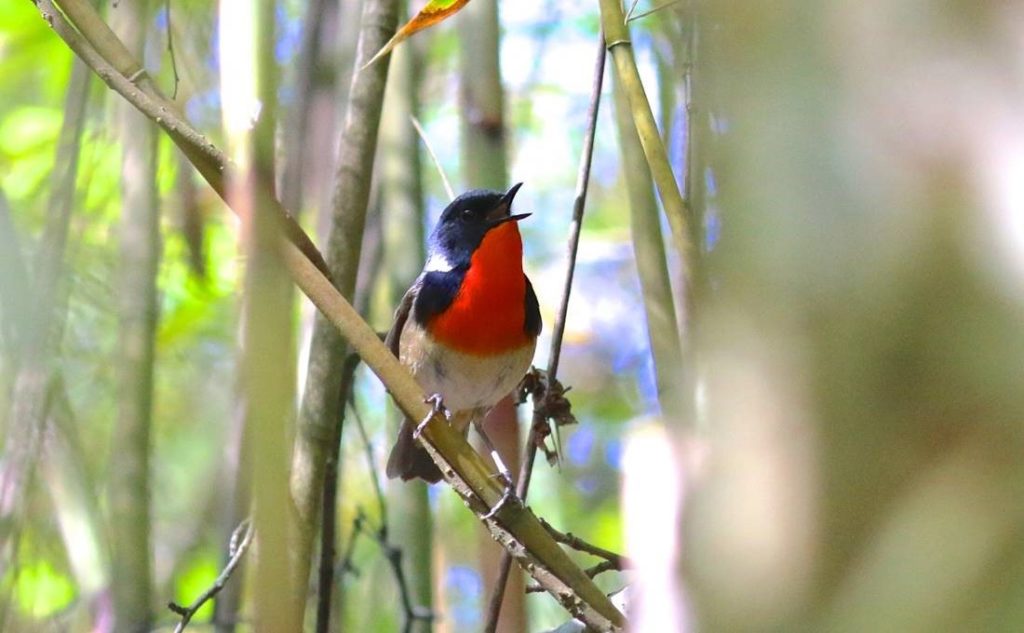
Some of the other highlights possible over the two days include Golden-breasted Fulvetta, Streaked Barwing, Sichuan Treecreeper, Red-winged Laughingthrush, Spotted Laughingthrush, Elliot’s Laughingthrush, White-browed Laughingthrush, Black-faced Laughingthrush, Chinese Babax, Emei Shan Liocichla, Red-billed Leiothrix, Chinese Blue Flycatcher, Yellow-throated Bunting, Forest Wagtail, Scaly-breasted Wren-Babbler, Firethroat, Chestnut-headed Tesia, Spotted Bush Warbler, Sichuan Bush Warbler, and White-bellied Redstart.
Along the beautiful watercourses of the area, we might find Common Kingfisher, Brown Dipper, Little Forktail, White-crowned Forktail, and Spotted Forktail, all great birds.
Overnight: Longcanggou Forest Park
Day 5. Longcanggou Forest Park to Labahe Nature Reserve
After a final morning birding at Longcanggou we travel to Labahe. We will keep an eye open for any interesting birds along the way.
Overnight: Labahe Nature Reserve
Day 6. Birding Labahe Nature Reserve
We will spend the full day birding at, and around the excellent Labahe Nature Reserve, where we will look for plenty more exciting birds like Temminck’s Tragopan, Lady Amherst’s Pheasant, Specked Wood Pigeon, Himalayan Swiftlet, Salim Ali’s Swift, Bearded Vulture, Himalayan Vulture, Eurasian Three-toed Woodpecker (and eight other species), Long-tailed Minivet, Spotted Nutcracker, Fire-capped Tit, Pere David’s Tit, Chinese Cupwing, Pygmy Cupwing, Asian House Martin, Collared Finchbill, Black Bulbul, Sichuan Leaf Warbler, and Large-billed Leaf Warbler.
There are many stunning gamebirds possible on this Sichuan tour, one of the best must be Lady Amherst’s Pheasant (photo Summer Wong).
Other birds we will look for during the day include Great Parrotbill, Brown Parrotbill, Fulvous Parrotbill, Three-toed Parrotbill, and Golden Parrotbill, Emei Shan Liocichla, Stripe-throated Yuhina, White-collared Yuhina, Elliot’s Laughingthrush, Black-faced Laughingthrush, Red-winged Laughingthrush, Red-billed Leiothrix, White-throated Dipper, Chinese Thrush, Chestnut Thrush, Ferruginous Flycatcher, Fujian Niltava, Daurian Redstart, Grey-headed Bullfinch, Slaty Bunting, and the stunning Firethroat, along with many more interesting species. We also have a possibility of finding the rare and beautiful Red Panda while here.
Overnight: Labahe Nature Reserve
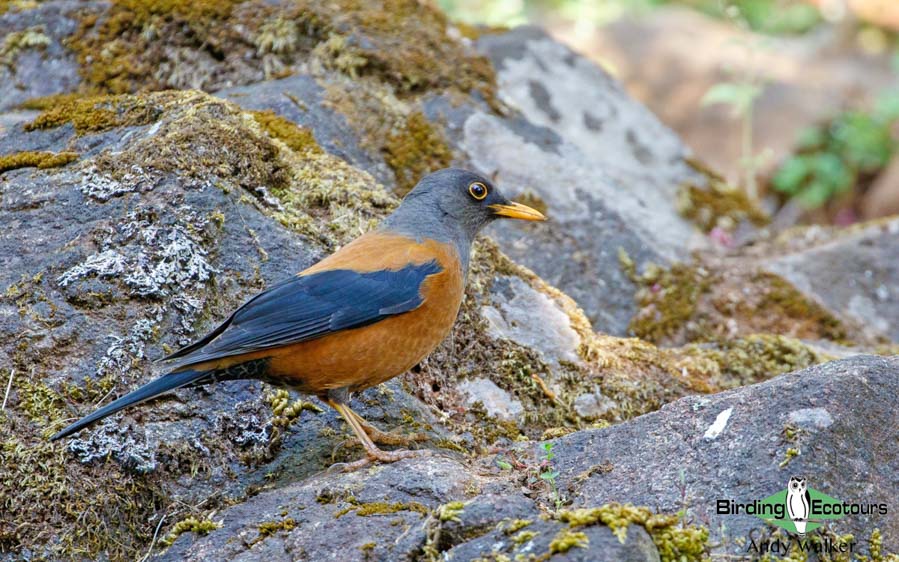
Day 7. Labahe to Wolong National Nature Reserve
After a final morning birding at Labahe we travel to Wolong National Nature Reserve; again, we will look out for interesting birds along the way.
Overnight: Wolong National Nature Reserve
Days 8 – 9. Birding Balang Shan
Based in Wolong National Nature Reserve at around 4,900 feet (1,500 meters), we will spend two days birding across a wide altitudinal range to beyond 14,750 feet (4,500 meters) in the impressive mountains of Balang Shan. We will spend time birding in and around a stunning landscape made up of wooded valleys, raging mountain rivers, alpine scrubs and meadows, and rocky scree slopes (including the famous ‘Balang Shan Tunnel’ where around 200 species have been recorded.
This is one of the best areas in Sichuan for gamebirds, and we will look for Chinese Monal, White Eared Pheasant, Tibetan Snowcock, Snow Partridge, Golden Pheasant, Verreaux’s Monal-Partridge, Koklass Pheasant, and Blood Pheasant during our time in the mountains.
We will look for White Eared Pheasant at higher elevations and we will also look for Blue Eared Pheasant later in the tour (photo Summer Wong).
There are plenty of other magnificent birds to be found here too (especially rosefinches), with opportunities for species such as Red-fronted Rosefinch, Streaked Rosefinch, Spot-winged Rosefinch, Chinese Beautiful Rosefinch, Chinese White-browed Rosefinch, Dark-breasted Rosefinch, and Crimson-browed Finch.
Other exciting birds include Grandala, Wallcreeper, Firethroat, Himalayan Bluetail, Golden Bush Robin, White-browed Bush Robin, Giant Laughingthrush, Chinese Rubythroat, Crested Tit-warbler, Collared Grosbeak, White-winged Grosbeak, Snow Pigeon, Spotted Bush Warbler, Sichuan Tit, Kessler’s Thrush and Chestnut Thrush.
Overnight: Wolong National Nature Reserve
There are a lot of spectacular birds on this tour and Grandala is one of the best (photo Summer Wong)!
Day 10. Wolong to Maerkang
Essentially a travel day as we move between Wolong and Maerkang. We will look for birds along the way, like Long-tailed Rosefinch, Blue Rock Thrush, and Yellow-streaked Warbler.
Overnight: Maerkang
Day 11. Birding at Mengbi Shan
The mountain of Mengbi Shan is in the transitional zone between the Sichuan Basin and the Qinghai-Tibetan Plateau and provides some important habitat for a wide range of species. There are a number of target birds for us here, such as Sichuan Jay, Verreaux’s Monal-Partridge, Blood Pheasant, Giant Laughingthrush, Himalayan Bluetail, Chinese Beautiful Rosefinch, Pink-rumped Rosefinch, Chinese White-browed Rosefinch, Three-banded Rosefinch, and Black Woodpecker.
Overnight: Maerkang
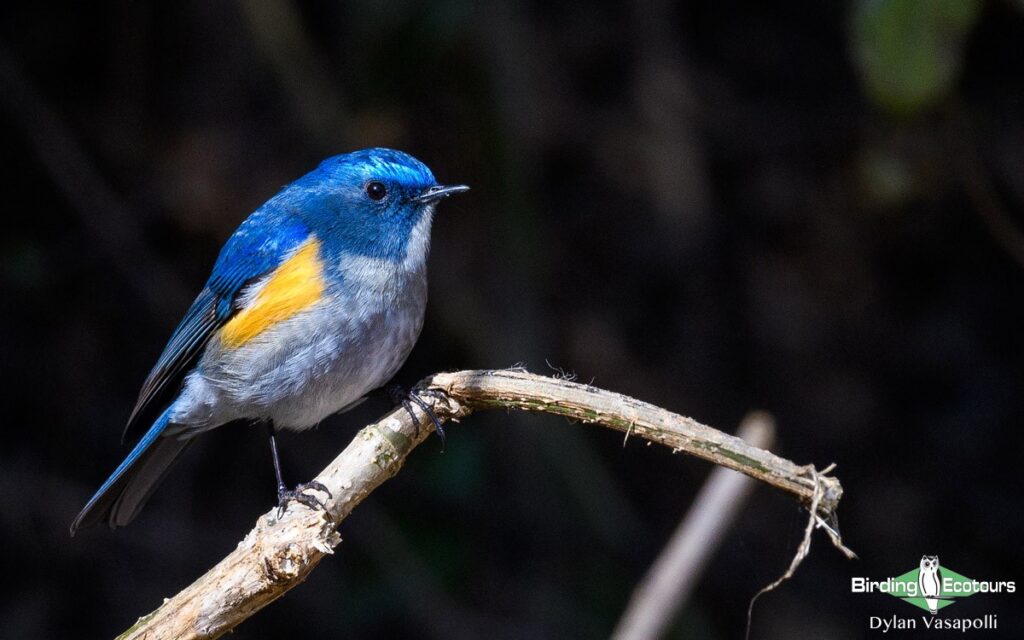
Day 12. Travel from Maerkang to Ruoergai
We will travel between Maerkang and Ruoergai; along the way we will look for Tibetan Partridge, Plain Laughingthrush, Azure-winged Magpie, Saker Falcon, White-browed Tit-warbler, Sichuan Tit, White-browed Tit, Tibetan Snowfinch, Przevalski’s Finch (a monotypic and highly sought-after family), Little Owl, and Black-necked Crane.
Overnight: Ruoergai
Day 13. Birding at Baxi Forest and Flower Lake
There are many exciting birds and other wildlife at the Baxi Forest and Flower Lake, such as Blue Eared Pheasant, Chinese Grouse, Three-banded Rosefinch, Przevalski’s Nuthatch, Snowy-cheeked Laughingthrush, Slaty-backed Flycatcher, Eurasian Three-toed Woodpecker, Tibetan Lark, Horned Lark, Rufous-necked Snowfinch, and White-rumped Snowfinch.
The wetlands here are known as ‘the lungs of Sichuan’ and are the most important wetlands in the province. The abundant food resources attract a range of waterbirds such as Bar-headed Goose, Greylag Goose, Ruddy Shelduck, and Ferruginous Duck. The highly sought-after Black-necked Crane is possible here too. We will also have the chance of seeing the amazing Tibetan Fox, Tibetan Wolf (a subspecies of Grey Wolf), Himalayan Marmot, and Plateau Pika here.
Overnight: Ruoergai
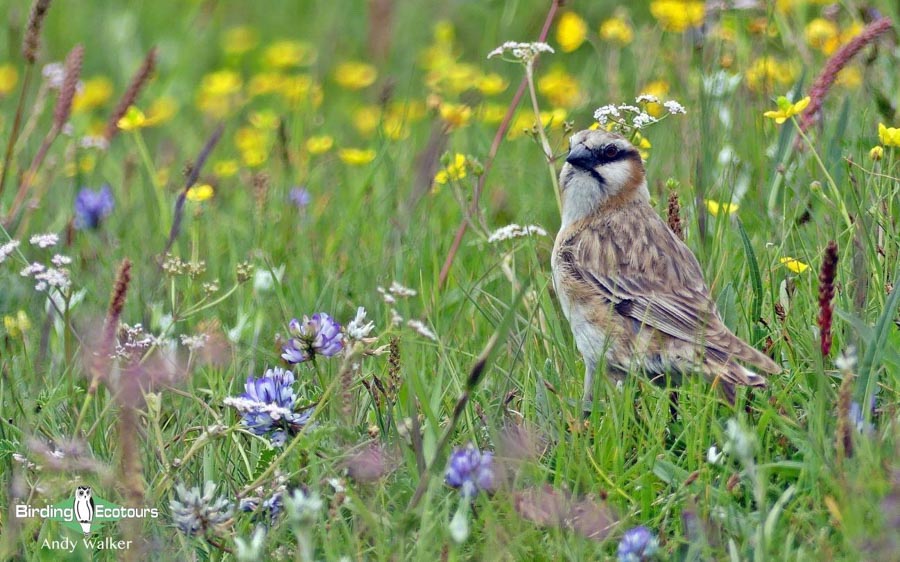
Day 14. Travel Ruoergai to Chuanzhusi
We will have a final morning birding around the Ruoergai area and then will travel to Chuanzhusi. Along the way we will look for Collared Crow, Wallcreeper, Black-streaked Scimitar Babbler, Eastern Crowned Warbler, Vinous-throated Parrotbill, Spectacled Fulvetta, Chestnut-crowned Bush Warbler, Spotted Bush Warbler, Pere David’s Tit, Olive-backed Pipit, and Giant Laughingthrush.
Overnight: Chuanzhusi
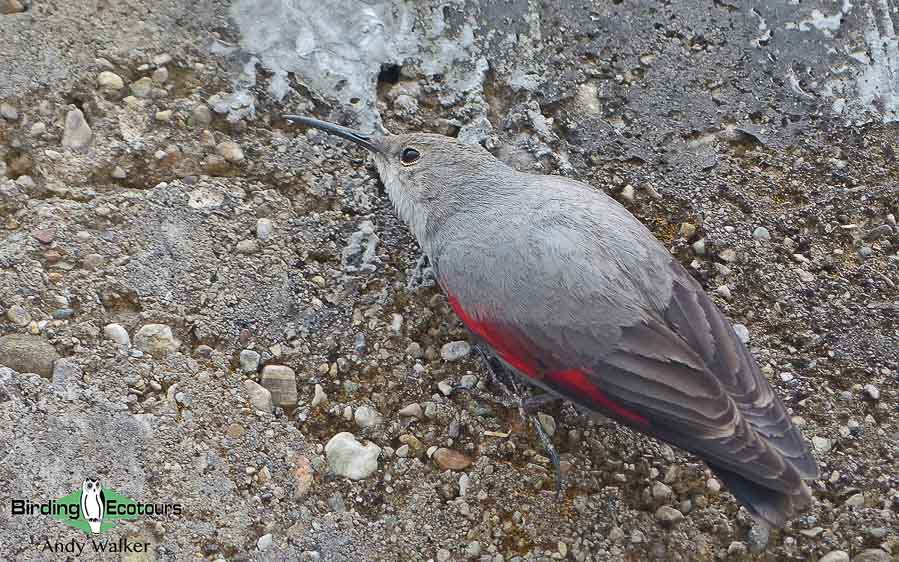
Day 15. Birding at Gonggangling
We will spend time in the forest area of Gonggangling, looking for Chinese Grouse, Blue Eared Pheasant, Crested Tit-warbler, White-browed Tit-warbler, Three-banded Rosefinch, Przevalski’s Nuthatch, Maroon-backed Accentor, Hodgson’s Treecreeper, Sichuan Treecreeper, White-bellied Redstart, Spectacled Fulvetta, and Pere David’s Owl. Other possibilities include Golden Eagle, Himalayan Buzzard, Upland Buzzard, Sichuan Jay, Oriental Magpie, Spotted Nutcracker, Red-billed Chough, Rufous-vented Tit, Grey Crested Tit, Sichuan Tit, Giant Laughingthrush, Plain (Pere David’s) Laughingthrush, Goldcrest, Eurasian Wren, Kessler’s Thrush, Chestnut Thrush, Long-tailed Thrush, Siberian Rubythroat, White-throated Redstart, and White-winged Grosbeak.
Overnight: Jiuzhaigou
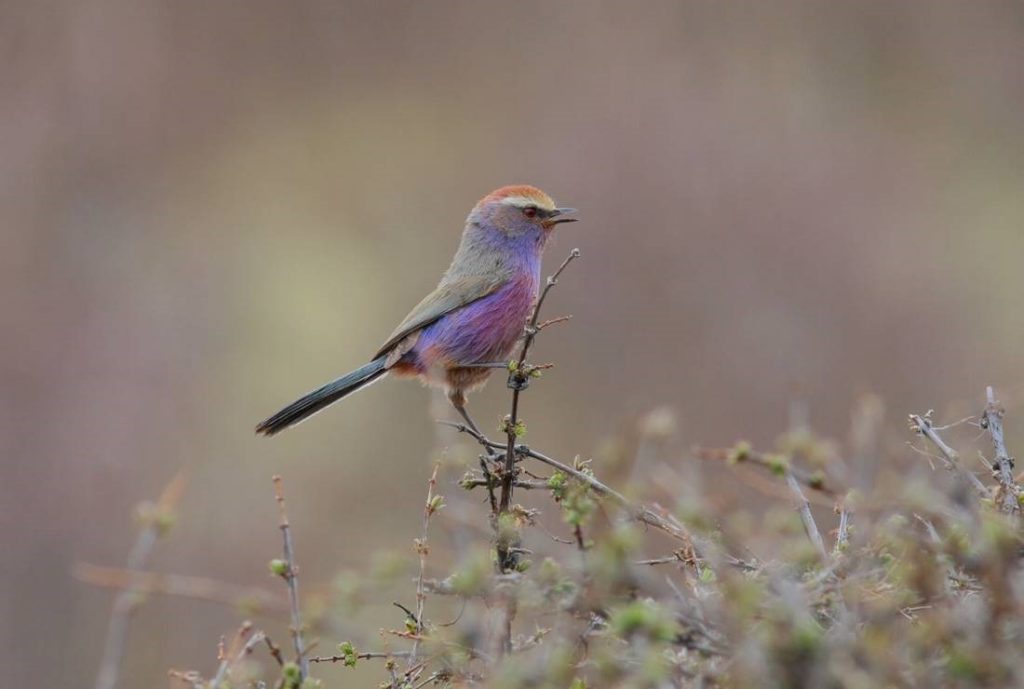
Day 16. Birding Jiuzhai Valley National Park
Jiuzhai National Park is a beautiful place full of exciting and stunning birds (around 300 species have been recorded here), and we will try and find as many of these as possible, focusing on the birds we have not yet seen on the tour including, with luck, the rare Rufous-headed Robin. Other targets will include Spectacled Parrotbill, Spectacled Fulvetta, Sooty Bushtit, Fujian Niltava, Sichuan Treecreeper, White-cheeked Laughingthrush, Indian Blue Robin, Pere David’s Tit, Slaty-backed Flycatcher, Chinese Nuthatch, Eurasian Nuthatch, Black Woodpecker, White-bellied Redstart, Brown Dipper, and White-throated Dipper.
Overnight: Jiuzhaigou
Day 17. Jiuzhaigou to Chengdu
We will spend the day traveling between Jiuzhaigou and Chengdu. We will have a final evening meal together and reminisce about the wonderful tour we have just concluded.
Overnight: Chengdu
Day 18. Departure from Chengdu
A non birding day. Departure from Chengdu or continue on our China: Qinghai Tour.
Overnight: Not included (unless you continue on the Qinghai Tour)
Please note that the itinerary cannot be guaranteed as it is only a rough guide and can be changed (usually slightly) due to factors such as availability of accommodation, updated information on the state of accommodation, roads, or birding sites, the discretion of the guides and other factors. In addition, we sometimes have to use a different international guide from the one advertised due to tour scheduling.
Download ItineraryChina, Sichuan: Custom Trip Report
JUNE – JULY 2018
By Andy Walker
DOWNLOAD TRIP REPORT
Overview
This 19-day custom China tour visited the province of Sichuan and commenced in Chengdu on the 23th of June 2018 and concluded back there on the 11th of July 2018. The focus of the tour was trying to photograph the species found in the province.
After leaving Chengdu we started our birding in the high mountains of the Balangshan area (between approximately 3,500-4,500m), before dropping lower to Labahe where we birded at around 2,500m. After our stop in Labahe we continued to the city of Luding to go birding between 2,000-3,500m at Earlangshan. Our next location, Longcanggou is a really beautiful forest and we concentrated our efforts in the zone between 1,200-2,000m. We made a brief afternoon visit to some rice paddies near Jiangyou before continuing to the picturesque Tangjiahe area (1,500m). Following an unexpected diversion due to some flooding we reached Gonggangling Forest where we spent time in the mountains at around 3,500m. After a long drive we found ourselves in a very different environment, that of the very impressive Tibetan Plateau. This area may be part of China, but it is quite clearly Tibet and it was great fun birding around Ruoergai. The plateau is at around 3,500m with hundreds of peaks bursting out from the vast plains. Really beautiful scenery here, and some fantastic birding, probably some of the most enjoyable of the tour. The final stop of our tour saw us heading back into the high mountains (c4,000m) at Mengbishan before returning to Chengdu where the tour concluded.
A total of 218 bird species were seen (plus eight species heard only), along with several other animals, including Himalayan Marmot, Tibetan Macaque, Yellow-throated Marten, Plateau Pika, Tibetan Fox, and Chinese Goral. Species lists are at the end of this report.
Some of the highlight birds included: Snow Partridge, Verreaux’s Monal-Partridge, Tibetan Snowcock, Blood, Koklass, and Lady Amherst’s Pheasants, Himalayan Vulture, Upland Buzzard, Chinese Sparrowhawk, Black-necked Crane, Snow Pigeon, Salim Ali’s Swift, Saker Falcon, Azure-winged Magpie, Red-billed Blue Magpie, Spotted Nutcracker, Alpine and Red-billed Choughs, Daurian Jackdaw, Collared Crow, White-browed Tit, Ground Tit, Tibetan Lark, Alpine Leaf Warbler, Sichuan Leaf Warbler, Sichuan Bush Warbler, Chinese Babax, Giant, Plain, and Elliot’s Laughingthrushes, Emei Shan Liocichla, Golden-breasted, David’s, and Chinese Fulvettas, Rufous-tailed Babbler, Vinous-throated, Ashy-throated, and Golden Parrotbills, Grandala, Kessler’s Thrush, Grey-winged Blackbird, Zappey’s Flycatcher, Indian Blue Robin, Chinese Rubythroat, Firethroat, Himalayan Bluetail, Little and White-crowned Forktails, White-throated, Daurian, White-capped, and Blue-fronted Redstarts, White-throated and Brown Dippers, Russet and Rock Sparrows, Tibetan, White-rumped, and Rufous-necked Snowfinches, Alpine and Rufous-breasted Accentors, Przevalski’s Finch, Grey-headed and Brown Bullfinches, Dark-breasted, Streaked, Chinese Beautiful, Pink-rumped, Dark-rumped, Sharpe’s, Vinaceous, Chinese White-browed, and Red-fronted Rosefinches, Grey-capped and Black-headed Greenfinches, Red Crossbill, and Slaty and Yellow-throated Buntings.
Detailed Report
Day 1, 23rd June 2018. Chengdu, travel to Wolong, late afternoon birding at Balangshan
We met our local guide, Summer, and excellent driver, Mr. Liu, in Chengdu after breakfast and immediately started our journey northwest into the rather impressive mountains at Wolong. A bathroom break along the way produced our first birds of the trip, which included Japanese Tit, Red-billed Leiothrix, Daurian Redstart, Collared Finchbill, and Grey-capped Greenfinch.
After our first of many traditional local Chinese lunches we checked into our hotel and spent a couple of hours birding some higher elevation areas before dropping back down to help with our acclimatization. On our way up the mountain we got some wonderful eye-level looks at a small party of Himalayan Vultures cruising through the valley. As we walked around a few choice spots we found the stunning male Firethroat, Sharpe’s Rosefinch, Himalayan Bluetail, White-capped Redstart, Blue-fronted Redstart, and nesting Asian House Martin, along with Bianchi’s, Buff-barred, Claudia’s Leaf, and Greenish Warblers. Other interesting birds included Snow Pigeon, Chestnut Thrush, Plumbeous Water Redstart, Vinaceous and Common Rosefinches, and the rather elegant White-collared Yuhina.
Day 2, 24th June 2018. Balangshan
We set off from our hotel in darkness with the aim of being back at yesterday’s min-mountain birdwatching spot around dawn, which we were. The only problem was that the area was covered in low clouds with some accompanying drizzle. Unfortunately the low clouds and the drizzle turning into light rain would hamper us throughout most of the day, with poor visibility making things difficult. We spent time at a couple of different elevation zones during the day (around 3,500m and 4,500m), and despite the weather situation we still came away seeing some great birds. Highlights were Snow Partridge and Snow Pigeons, the latter giving some excellent views as they bathed and preened near a river. Chinese Rubythroat (a result of a recent spilt of the Himalayan/White-tailed Rubythroat complex) eventually showed well, with two males singing from bush tops and a female spotted running around on the ground in the area too.
We did really well for rosefinches, and over the course of the day found Dark-breasted, Streaked, Pink-rumped, Chinese White-browed, Red-fronted, and Common Rosefinches, some very pretty birds there. Also very pretty were the male Blue-fronted Redstarts seen (along with the abundant White-capped Redstarts and Plumbeous Water Redstarts). Plain Mountain Finches were quite numerous here, as were Alpine Accentors. A lone Rufous-breasted Accentor was also noted, as was a pair of Grey-headed Bullfinch. Rosy Pipits were rather plentiful higher up, and a couple of Common Cuckoos were found, presumably looking for pipit nests. A welcome splash of color in one gloomy mountain area around lunchtime was provided by a Eurasian Hoopoe, our only sighting of the whole tour in a rather unlikely spot!
As we came off the mountain we came across a flock of Salim Ali’s Swifts and at least one White-throated Needletail, and a White-throated Dipper was found in a section of whitewater rapids.
Back at our hotel a pair of Red-billed Blue Magpies were vocalizing, and Collared Finchbill and Blue Whistling Thrush were in the vegetable garden, with an impressive flock of nearly one hundred Asian House Martins overhead (along with more Salim Ali’s Swifts). So, despite the poor weather, some great birds!
Day 3, 25th June 2018. Balangshan
We followed the previous day’s routine in the morning and headed to the Balangshan Pass. It was again cloudy but generally drier, and we had several breaks in the clouds to enable us to find some of our target birds. Top of the list were Tibetan Snowcock and Grandala that we saw during such breaks in the weather. We again saw a lot of the birds seen the previous day, improving our views of White-throated Redstart (a stunning male) and Dark-breasted and Red-fronted Rosefinches. New additions included Red-billed Chough, several Kessler’s Thrushes (including a family group with recent fledglings), Koklass Pheasant, Himalayan Buzzard, Hill Pigeon, Eurasian Wren, Two-barred Warbler, and Olive-backed Pipit. We also found Himalayan Marmot, Chinese Goral, and many Domestic Yaks.
After a break back at our hotel we took a short walk up a small hill through some agricultural land, where we found some interesting birds and had some great views of most. Highlights over a couple of hours before the rain came down included numerous singing Chestnut Thrushes, Oriental Turtle Dove, Long-tailed Minivet, Green-backed Tit, Collared Finchbill, Elliot’s Laughingthrush, White-collared Yuhina, Verditer Flycatcher, Grey Bush Chat, and Mrs. Gould’s Sunbird. However, the best birds were probably the group of nearly a dozen Red Crossbills, a surprise male Grey-winged Blackbird, and a gorgeous male Daurian Redstart.
Day 4, 26th June 2018. Wolong to Labahe
This was essentially a travel day as we moved southwest from Wolong to Labahe. Our already-long travel day was compounded by a landslide that had us waiting for five hours while it was being cleared up. Luckily we had access to toilets, restaurants, and a few birds to pass some time, with breeding behavior noted in Blue Rock Thrush, Daurian Redstart, Light-vented (Chinese) Bulbul, Green-backed Tit, White Wagtail, and Eurasian Tree Sparrow. All were either building nests, feeding nestlings, or had recently-fledged young. While waiting for the road to reopen we also found Black Bulbul, Collared Finchbill, White-browed Laughingthrush, and Red-rumped Swallow.
As we finally continued our journey we drove through plenty of tea plantations and noted several widespread Asian species such as Crested Myna, Spotted Dove, and Eastern Cattle Egret.
After a nice dinner we continued our very long day, eventually arriving at our truly comfortable hotel in the evening, much later than expected due to the unforeseen landslide slowing our progress considerably.
Day 5, 27th June 2018. Labahe
After a long day of travel the previous day it was nice to be back out birding, and the weather generally behaved too, until right at the end of the day. Our morning birding produced several waves of excitement as we found a number of new species for the tour or improved on sightings and photographs of others. A small flock of the very large White-throated Needletails were flying low over the lake in front of our hotel, dwarfing the tiny Asian House Martins that were doing likewise. Driving along the road to our hiking spot we first found a flock of approximately thirty Speckled Wood Pigeons and then a female Lady Amherst’s Pheasant sitting low in a tree, and a short while later we found a male too – rather nice birds indeed!
After an uphill hike into a forest we could hear one of our target birds, but unfortunately the Temminck’s Tragopan remained hidden deep in the undergrowth. Here, however, we did find Stripe-throated Yuhina, Eurasian Nuthatch, Aberrant Bush Warbler, Sichuan Leaf Warbler, many Claudia’s Leaf Warblers, and a couple of Coal Tits. After a while we moved to some different areas and found other interesting birds, such as Bianchi’s Warbler, Yellow-bellied, Green-backed, and Yellow-browed Tits, Large-billed Leaf Warbler, Ashy-throated Warbler, Vinaceous Rosefinch, Grey-hooded Fulvetta, Rufous-gorgeted Flycatcher, White-collared Yuhina, and Red-billed Leiothrix. Most exciting, though, was probably the views we had of half a dozen Red-billed Blue Magpies and nearly a dozen Spotted Nutcrackers foraging in the same area.
The afternoon birding session near our accommodation was cut short by some pretty heavy rain, but we saw a few of the species mentioned before (Plumbeous Water Redstart, White-capped Redstart, Long-tailed Minivet, and Grey Wagtail). An Indian Blue Robin was calling but would not break cover, being seen only briefly. We did also enjoy watching a couple of troops of Tibetan Macaques roving around the hotel complex and creating their usual mischief.
Day 6, 28th June 2018. Labahe to Luding via Erlangshan
We again awoke to light rain, but it was clear looking at (and hearing) the river that was roaring and a lot higher than on the previous day; there must have been an awful lot of rain overnight. Luckily there were no major landslides, but some very impressive waterfalls were pouring off the mountainsides. We headed out to the same area as on the previous morning and saw a lot of the same birds, including lots of Phylloscopus warblers such as Sichuan Leaf Warbler, Large-billed Leaf Warbler, Ashy-throated Warbler, Buff-barred Warbler, Claudia’s Leaf Warbler, and Greenish Warbler. A female Lady Amherst’s Pheasant with four young chicks was nice to see here too. We also had a couple of different birds to the previous day, such as very good views of Pygmy Wren-babbler, brief views of a pair of Fujian Niltavas, prolonged views of Grey-headed Woodpecker, and also some close-range Spotted Nutcrackers to improve on the already good views we’d had previously.
In the late-morning we started our journey to Luding, our base for the next couple of nights. Along the way we found Hair-crested Drongo, Red-billed Blue Magpie, Kloss’s Leaf Warbler, Marten’s Warbler, Japanese White-eye, and best of all a Little Forktail that was making the most of some roadworks and was actually foraging along the highway!
Day 7, 29th June 2018. Erlangshan
We had a really enjoyable day birding at Erlangshan, and the weather cooperated too, which was a definite bonus. As we drove up the mountain we found a small flock of Eurasian Magpies, Grey-backed Shrike, and best of all a flock of twenty Black-headed Greenfinches feeding in wildflower seeds. Brown-breasted Bulbuls were present, as were a couple of female Lady Amherst’s Pheasants with babies. One stop gave us brief glimpses at a male Firethroat, a female Slaty-blue Flycatcher, Japanese Tit, and the local specialty Rufous-tailed Babbler, which showed well.
As we continued up the mountain a few stops along the way yielded many birds. One of the best stops again involved a male Firethroat, but also gave us prolonged views of White-browed Fulvetta, Grey-crowned Warbler, White-crowned Yuhina, Yellow-bellied Tit, and some simply incredible views of almost a dozen Red Crossbills that were feeding a mere six feet in front of us at eye-level! Just as spectacular were the two Yellow-throated Buntings seen along the road.
Higher still, and we found a Red Turtle Dove feeding in the road and, once we had gained some elevation, Chestnut Thrushes and Spotted Nutcrackers were quite abundant, as were Olive-backed Pipits.
Now much nearer to the top of the mountain we spent time trying to photograph the many small passerines around, which was not always easy, but we had Mrs. Gould’s Sunbird (which must be one of the best-looking sunbirds in the world), Sharpe’s, Vinaceous, and Dark-rumped Rosefinches, Sichuan Leaf Warbler, Claudia’s Leaf Warbler, Buff-barred Warbler, Greenish Warbler, Bianchi’s Warbler, and Grey-hooded Fulvetta. A large female Peregrine Falcon cruised overheard and across the nearby valley before drifting out of sight.
Both Common and Lesser Cuckoos were recorded, with Chestnut Thrushes seemingly particularly alarmed by their presence. Two small groups of Chinese Babax and Elliot’s Laughingthrushes were also seen as we dropped down off the top of the mountain to start our journey back to our hotel in Luding in order to spend a couple of hours relaxing before dinner. We picked up a few different birds on the way down, such as Streak-breasted Scimitar Babbler and Crested Honey Buzzard.
Day 8, 30th June 2018. Luding to Longcanggou
This was again essentially a travel day as we moved between Luding and Longcanggou. After arriving in Longcanggou in the mid-afternoon we took a brief walk near our accommodation, finding a pair of Ashy-throated Parrotbills, a pair of Brown Bullfinches, and several Brown-flanked Bush Warblers. We also saw Common Cuckoo, Large Hawk-Cuckoo, several Light-vented and Black Bulbuls (the latter of the white-headed morph), many Grey-headed Greenfinches, and a lone Verditer Flycatcher.
Day 9, 1st July 2018. Longcanggou
We spent the morning birding at the low and middle elevations of Longcanggou and had an enjoyable few hours, with excellent weather thrown in too. As we drove up the mountain we had very brief views of Chinese Bamboo Partridge, Lady Amherst’s Pheasant (another female with babies), and Temminck’s Tragopan, but unfortunately none were seen by all, though we saw more cooperative White-browed Laughingthrushes and Red-billed Blue Magpies.
After breakfast on the mountain we spent some time getting looks at the rather tricky, secretive, and restricted-range Emei Shan Liocichla. A Pygmy Wren-babbler was keeping to the dense understory vegetation, but then we got some good views of the very secretive and only recently described (2015) Sichuan Bush Warbler, this bird appearing invisible at times as it moved between bushes on the ground like a mouse!
A short while later we were enjoying a lot of mixed-species activity in the form of Eurasian Nuthatch, Long-tailed Minivet, Slaty Bunting, Chestnut-crowned Warbler, Yellow-bellied, Green-backed, and Yellow-browed Tits, Grey-capped Pygmy Woodpecker, and Mrs. Gould’s Sunbird, with Eurasian Sparrowhawk and Himalayan Swiftlet overhead.
As we walked down the mountain access road over the course of the morning we saw most of the above-mentioned species again but also found several others, such as White-crowned Forktail, Red-billed Leiothrix, Grey-headed Canary-Flycatcher, Blue-winged Minla, Red-tailed Minla, David’s Fulvetta, and Rufous-capped Babbler. We also had great looks at several Kloss’s Warblers (along with many Claudia’s Leaf Warblers and Large-billed Leaf Warblers), a small flock of Golden Parrotbills, and the gorgeous Golden-breasted Fulvetta. Red-winged and Buffy Laughingthrushes as well as Streak-breasted Scimitar Babbler were all heard but kept well hidden in the densely-vegetated undergrowth.
As the heat of the middle of the day picked up and the activity dropped off we decided to head back to our accommodation for a break, after which we had a walk around it, finding a flock of twenty Brown Bullfinches, several David’s Fulvettas, Black Bulbul, Grey-crowned Greenfinch, White-throated Needletail, Brown and Long-tailed Shrikes, Brown-flanked Bush Warbler, Grey Bush Chat, and White-browed Laughingthrush.
Day 10, 2nd July 2018. Longcanggou to Jiangyou
This was another travel day as we drove north from Longcanggou back around Chengdu (through some tremendous thunderstorms and torrential rain) and continued on to Jiangyou, where we arrived mid-afternoon.
After a short break at our luxurious hotel we ventured out into some rice paddies on the edge of town, where during a brief visit we found several Red-billed Starlings, a flock of Chinese Blackbirds (including several young birds), and a few other new trip birds, such as Black Drongo, Oriental Magpie-Robin, Plain Prinia, Chinese Pond Heron (looking rather sharp in breeding plumage), Eastern Cattle Egret, and Little Egret. We then returned to our accommodation and enjoyed a wonderful buffet dinner.
Day 11, 3rd July 2018. Jiangyou to Tangjiahe Natural Nature Reserve
We spent the morning driving between Jiangyou and Tangjiahe, arriving at out accommodation in time for lunch. Most of the journey was through rain, so little was observed along the way. But we did have a good look at a pair of Brown-breasted Bulbuls and Collared Finchbills, several Japanese White-eyes, and singing and showing Brown-flanked Bush Warbler at the park entrance checkpoint, with numerous Plumbeous Water Redstarts along the many kilometers along rivers we drove through the morning. Several Daurian Redstarts were noted in the villages we passed through, with plenty of Red-rumped Swallows present too.
After lunch we took a walk along the river near our accommodation for a couple of kilometers. It was generally quiet, despite the much better weather, but we did find Chinese Sparrowhawk, Black-chinned Yuhina, Brown Dipper, a pair of White-crowned Forktails (actually quite showy for forktails), Mountain Bulbul, Kloss’s Leaf Warbler, Green-backed Tit, Common Swift, and Great Spotted Woodpecker (along with dozens more Plumbeous Water Redstarts).
Day 12, 4th July 2018. Tangjiahe
After breakfast we headed out for a walk around our hotel grounds, where we found a roving flock of Red-billed Blue Magpies, Daurian Redstart, Plumbeous Water Redstart, White Wagtail, Grey Wagtail, and Green-backed Tit – all the usual suspects.
As we headed further afield we found a bit of a mixed-flock that included Yellow-bellied Tit, Sulphur-breasted Warbler, Ashy-throated Warbler, Grey-headed Canary-flycatcher, Black-chinned Yuhina, Mrs. Gould’s Sunbird, Fire-breasted Flowerpecker, Chestnut-flanked White-eye, and Mountain Bulbul, but best of all was a Zappey’s Flycatcher that hung around for a while. Walking a little further we saw more Red-billed Blue Magpies, Large-billed Crow, several Eurasian Jays, and a pair of Great Barbets.
We dropped a bit lower down the river and found Red-billed Leiothrix, David’s Fulvetta, Alström’s Warbler, Kloss’s Leaf Warbler, and Japanese White-eye. Here we also had excellent, prolonged views of the often shy and secretive Crested Kingfisher and a couple of Brown Dippers – great fun watching the dippers feeding underwater!
During the afternoon we took a walk along a smaller river valley and spent some time with a mixed flock of birds that were mobbing a Yellow-throated Marten. Birds present included Streak-throated Scimitar Babbler, David’s Fulvetta, Black-throated Bushtit, Rufous-faced Warbler, Sulphur-breasted Warbler, Black-chinned Yuhina, Asian Koel, Yellow-bellied Tit, and Collared Finchbill.
Day 13, 5th July 2018. Tangjiahe to Jiuzhaigou
It turned out to be a lengthy travel day as we left Tangjiahe, initially heading to our scheduled destination of Chuanzhusi. However, after a road closure over half way through our journey through a valley (with one road) we had to subsequently backtrack our route for several hours. This could have been avoided had the police not being asleep at their post to tell us about the road closure, extremely frustrating for us all. We rapidly made alternative plans for the night and we stopped in the town of Jiuzhaigou, which was actually a really nice hotel, just a shame our time there was so brief.
Earlier in the day we had seen Vinous-throated Parrotbill at a roadside stop along with Russet Sparrow, Brown-breasted Bulbul, and Hair-crested Drongo, as well as several other more common and widespread species, such as Collared Finchbill, Daurian Redstart, and Japanese White-eye. The only plus side to the road diversion was finding a small flock of Collared Crows along a river. We arrived at our new hotel much later than anticipated and headed straight to bed, very tired after an unexpectedly long day.
Day 14, 6th July 2018. Jiuzhaigou to Gonggangling Forest to Ruoergai
We were back in our van early in the morning to head to Gonggangling Forest. On arrival at a high point we were greeted to a vail of clouds, but luckily it wasn’t too thick and gradually lifted during the morning. We found a bit of activity and got glimpses of the secretive White-bellied Redstart, Chinese Thrush, Grey-headed Woodpecker, Buff-barred Warbler, Sichuan Leaf Warbler, White-throated Redstart, Daurian Redstart, Chestnut Thrush, Kessler’s Thrush, Elliot’s Laughingthrush, and Grey-backed Shrike.
As we walked down the road a Lesser Cuckoo flew in and showed briefly, and we had further views of some very confiding Buff-barred Warblers. A nearby flock held Grey Crested Tit, Rufous-vented Tit, Goldcrest, Slaty-backed Flycatcher, Dark-sided Flycatcher, and Grey-headed Bullfinch, among others. We also had some excellent views of a very confiding male Chinese White-browed Rosefinch that gave prolonged views.
Around lunchtime we headed off the mountain and down into town for lunch. Afterwards we continued our journey, mainly on the Tibetan Plateau, and really enjoyed the change of scenery and traditional homesteads and villages. We picked up a few birds along the way, such as Himalayan Vulture, Northern Raven, Black (Black-eared) Kite, White-capped Redstart, Asian House Martin, and Ruddy Shelduck. We then hit some roadworks and again spent a couple of hours at the roadside waiting to get through. Here there were Horned Lark and Tibetan Lark and a lot of Chinese selfie-takers. After we got through the roadworks we continued to our base for the next couple of nights at Ruoergai. Just before we hit town we found one of the most-wanted birds of the trip, Black-necked Crane – a pair with one young bird. Fantastic to see! In this area we also saw Oriental Skylark, Common Pheasant, Azure-winged Magpie, and Common Redshank.
Day 15, 7th July 2018. Ruoergai Area
We spent the day exploring the Ruoergai area and saw some wonderful birds in some amazing landscape, interspersed with time spent stuck in roadworks and general road chaos associated with said roadworks, certainly very frustrating at times. But we persisted and saw some excellent restricted-range and highly-sought species throughout the day.
During the morning we found several new species, all giving excellent views. These included hundreds of White-rumped and Rufous-necked Snowfinches, many with fledged young. Ground Tits were busy taking nesting material into their cliff-hole nests while Upland Buzzards, Little Owl, and Saker Falcons also patrolled the skies and grasslands. We found a few Tibetan Foxes, presumably looking for baby Domestic Yaks or some of the hundreds of Plateau Pika or the fair few Himalayan Marmots we also enjoyed seeing.
Horned Lark, Tibetan Lark, and Oriental Skylark were also present and singing constantly in large numbers. Several Black-necked Cranes (distant), Ruddy Shelduck, Brown-headed Gull, Black Redstart, Black (Black-eared) Kite, Himalayan Vulture, and Northern Raven were also all noted as we traversed the area.
During the afternoon, after getting through the traffic chaos, we ventured into a different direction from town and found two highly-sought birds, first the endemic White-browed Tit and second Przevalski’s Finch, a monotypic family of ancient finches found in Tibet and China and a major target bird of the trip. After success with both of these birds we headed back to our hotel, seeing some more Saker Falcons, Himalayan Vultures, Upland Buzzards, Ruddy Shelducks, Common Redshanks, and three Black-necked Cranes along the way. The cranes were even heard calling, their ‘bugling’ ringing out across the stunning late-afternoon Tibetan Plateau landscape.
Day 16, 8th July 2018. Ruoergai to Maerkang
Another travel day as we moved between Ruoergai and Maerkang. We made a flew stops along the way, finding Tibetan Snowfinch, Rock Sparrow, Daurian Jackdaw, Black-necked Crane, Saker Falcon, Upland Buzzard, Azure-winged Magpie, Ruddy Shelduck, and Plain Laughingthrush along the way. We also enjoyed a rather wet male Przevalski’s Finch singing in the rain, although wet it was a better-colored individual than the bird found the previous day (which had been a young male).
Day 17, 9th July 2018. Mengbishan
After breakfast we headed to Mengbishan, at an altitude of about 4,000m, and we spent the majority of the day at that elevation, gradually walking down to around 3,600m. On our arrival at the summit we found a couple of distant Verreaux’s Monal-Partridges and had some very close views of a pair of Kessler’s Thrushes provisioning their nest. We also saw Chinese Beautiful Rosefinch, Hume’s Leaf Warbler, and Rufous-breasted Accentor. Chinese White-browed Rosefinches were abundant, and Common and Streaked Rosefinches were also found. Collared Grosbeak showed very briefly, but we had great views of numerous Blue-fronted Redstarts, White-throated Redstarts, and White-capped Redstarts – all seriously beautiful birds. Some of the other species found during the course of the day included Himalayan Buzzard, Oriental Turtle Dove, Grey-headed Woodpecker, Grey-backed Shrike, Rufous-vented Tit, Goldcrest, Chinese Fulvetta, Chestnut Thrush, Olive-backed Pipit, Grey-headed Bullfinch, and Himalayan Bluetail. However, one of the main highlights was seeing Blood Pheasant at close range; we had a few birds cross the road in front of us, one of them pausing briefly for photos!
Day 18, 10th July 2018. Maerkang to Chengdu
This was a full travel day as we left Maerkang after breakfast and returned to Chengdu for our final evening meal of the tour, which was a really nice one too.
Day 19, 11th July 2018. Departure
The tour concluded after breakfast with international departure from Chengdu.
Please see the downloadable PDF above with the full species lists included. This is a sample trip report. Please email us ([email protected]) for more trip reports from this destination.
